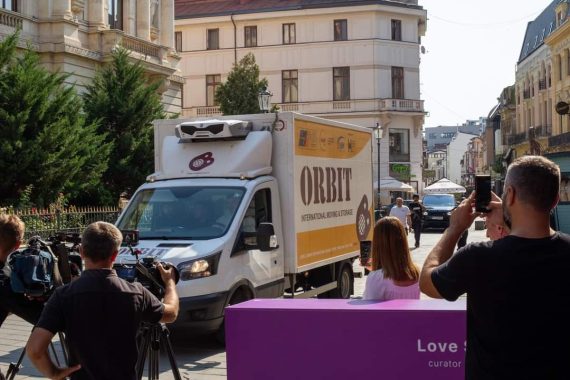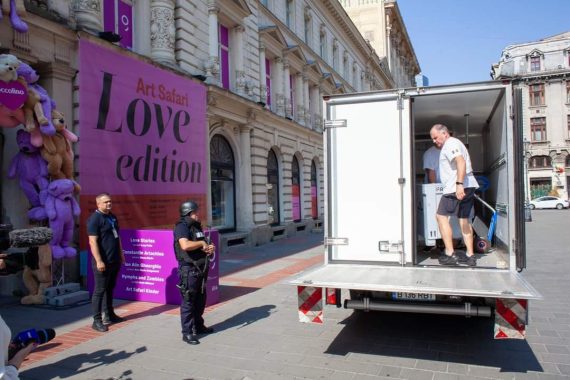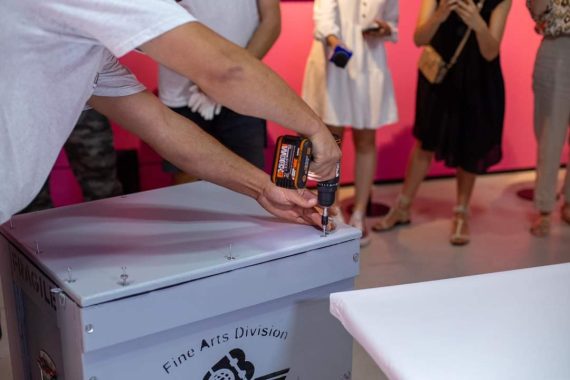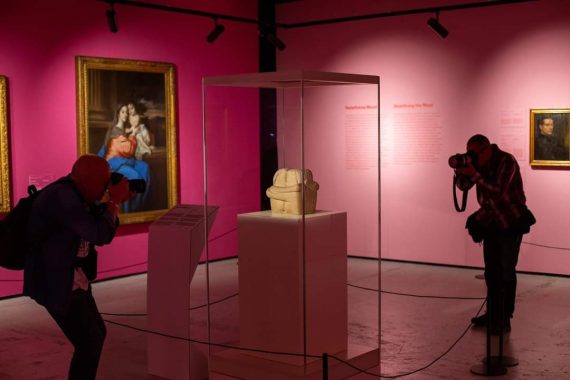The famous sculpture “The Kiss” (1907) by Constantin Brâncuși (1876-1957), the first of the Kisses cycle, can be seen at Art Safari Love Edition for ten days, between August 21-30.
The treasure, with an insurance value of 22 million euros, was transported from the Craiova Art Museum to Bucharest under maximum security conditions with a company specialized in fine art transport and escorted by the Romanian Gendarmerie. The masterpiece will be guarded around the clock at Art Safari.
The masterpiece will be exhibited as part of the “Love Stories” exhibition, made in collaboration with the National Portrait Gallery, London, being part of the Romanian art insertion dedicated to love.
The kiss exhibited at Art Safari, in the collection of the Craiova Art Museum, was made of marlstone in 1907 and is the first sculpture from the much-loved series of Kisses, on which Brâncuși worked for 40 years. “The Kiss” is one of the artist’s most famous masterpieces, along with “The Sleeping Muse” (1908), “Prometheus” (1911), “Miss Pogany” (1913), “Newborn” (1915), “The Bird in space” (1919) and “Endless Column” (1938).
The work was sculpted in a seemingly straightforward manner, not needing anatomical details and capturing the essence of the message. Brâncusi uses a personal stone-cutting technique.
The kiss is more of the gaze than of the lips. Each character’s field of vision includes only their partner’s eyes, emphasizing force expressed through the implausible proximity of the characters’ orbits.
In Brancușian Kiss, neither partner dominates the other; they have an equal relationship. This can be seen from the perfectly identical dimensions of the two silhouettes, which express an equivalence of status in physical terms. Brâncusi even affirmed during the entire cycle of the Kiss (1907-1945) that women and men are equal.
A version of the Kiss from 1910 serves as a tombstone in Montparnasse Cemetery in Paris, France, while another version can be seen at the Philadelphia Museum of Art.


“Brâncusi’s Kiss, the first of the famous cycle dedicated to love, finds its perfect place among the masterpieces at the National Portrait Gallery. We thank the Craiova Art Museum for the openness to lend us for ten days a masterpiece that completes the Love Stories exhibition we are hosting this season. It is a first for Art Safari, but also for the Capital. On this occasion, Art Safari will have a special visiting schedule, being open daily so that the public can admire it in as large a number as possible. They say that the first kiss is never forgotten, so we invite you to see it at Art Safari,” said Ioana Ciocan, CEO of Art Safari and Commissioner of Romania at the Venice Biennale.
“What matters in art is joy. You don’t necessarily need to understand theoretically. Does what you see make you happy? That’s all!” said Emilian Ștefărță, director of the Craiova Art Museum.
Art Safari also exhibits the love letters between Constantin Brâncuși and his muse, 35 years younger, the American dancer Florence Meyer. On one of them, Brâncusi even sketched the Kiss.
Constantin Brâncusi is the greatest Romanian artist and one of the most influential artists of universal art, who contributed to the renewal of contemporary sculpture and revolutionized modern art.
Tickets can be purchased on artsafari.ro or directly at the entrance, in the Dacia-România Palace, Lipscani Street, no. 18-20, Bucharest.
About Art Safari
Art Safari, supported by Glo, Lidl, BCR, Porsche, Schweppes, Kinder, Garanti BBVA, Rose Verite, Coccolino, Yamaha, and Asus, specializes in making exhibition pavilions. The annual organizer of the Bucharest Art Pavilion – the largest conglomerate of art exhibitions in Romania – now in its 12th edition, carries out extensive retrospective exhibitions in partnership with Romanian and international art museums and private collectors that propose the recovery of heritage values.
With a solid educational side, its mission is to bring art closer to the public and educate new generations by organizing art workshops for children, guided tours, and contemporary art exhibitions in unconventional spaces, such as Henri Coandă Airport or the Bucharest metro.
Art Safari is a strategic national cultural project supported by the Ministry of Culture. It is carried out with the Bucharest City Museum, the National Art Museum of Romania, and the Romanian Cultural Institute. The official Art Safari partner is BCR.
In the 11 editions so far, it has registered over 400,000 visitors.
About the Craiova Art Museum:
The Craiova Art Museum was established in 1908 under the name of Pinacoteca Alexandru y Aristia Aman. Since 1954, it bears the current name. The museum is located in the Constantin Mihail Palace, an architectural monument known as the Jean Mihail Palace.
Currently, the Museum’s heritage consists of over 8000 European and Romanian works of art, signed by the most illustrious names of Romanian painting and sculpture: Theodor Aman, Nicolae Grigorescu, Nicolae Tonitza, Ștefan Luchian, Gheorghe Petrașcu, Theodor Pallady, Eustațiu Stoenescu, Ion Țuculescu, Gheorghe Anghel, Dimitrie Paciurea.
The most valuable works owned by the museum are six sculptures by the titan of universal modern art, Constantin Brâncusi: Vitellius, Head of a Girl, Head of a Boy, Torso Fragment, Miss Pogany, and the Kiss.







Source image: Art Safari




